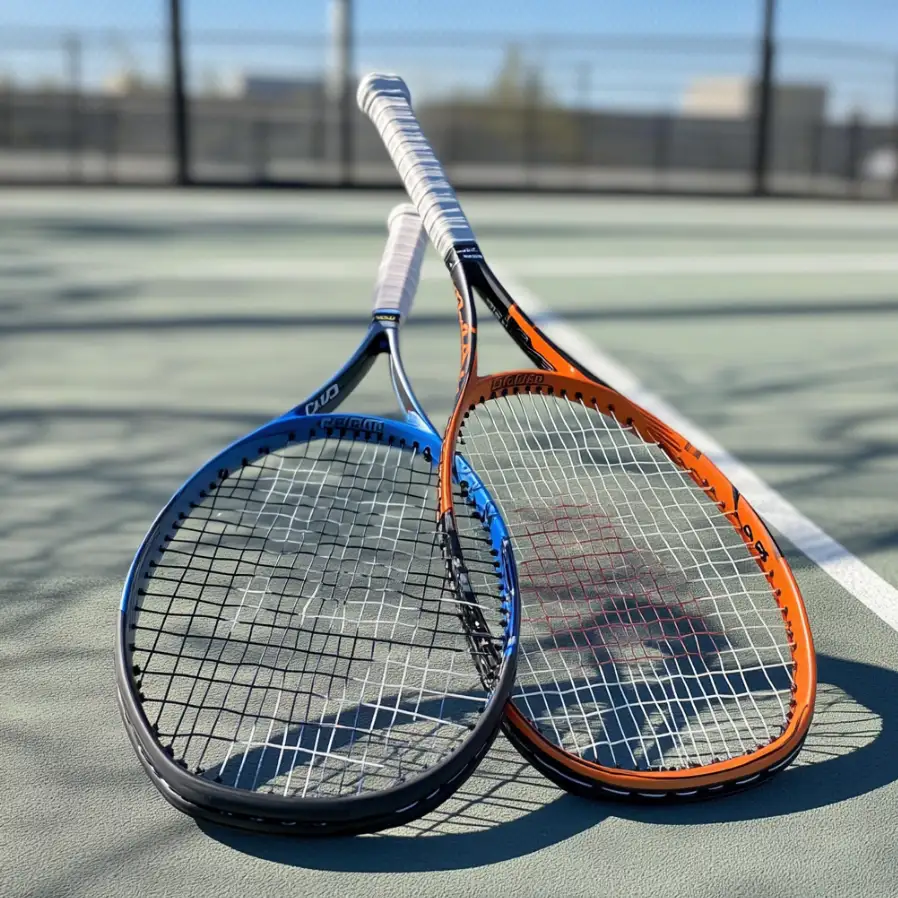Weight Classes: Light, Medium, and Heavy
Tennis rackets are generally categorized into three weight classes:
- Lightweight Rackets – Easier to maneuver and ideal for achieving fast swing speeds, making them popular among beginners and players who prioritize agility. However, they may lack the mass needed for powerful shots.
- Medium-Weight Rackets – Provide a balanced mix of power and control, offering enough heft to hit forcefully without sacrificing too much speed.
- Heavy Rackets – Favored by advanced players for added stability and power. While these rackets can deliver penetrating shots, they demand more strength and can be challenging to handle over extended play.
The choice of weight should align with a player’s strength, playing style, and skill level. Trying different weights can help players find the balance that enhances their unique game.
Balance Points: Head-Heavy, Head-Light, and Evenly Balanced
A racket’s balance point refers to the spot at which it balances horizontally. It is typically measured from the handle in millimeters and falls into one of three categories:
- Head-Heavy – The balance point is closer to the racket head, which enhances power but reduces maneuverability.
- Head-Light – The balance point is nearer to the handle, improving control and ease of movement, particularly advantageous for net play.
- Evenly Balanced – Offers a compromise between power and maneuverability, making it versatile for various playing styles.
The right balance can complement a player’s swing mechanics. Testing different balance configurations is key to finding a racket that feels natural and suits a player’s approach to the game.
Stiffness and Swing Weight
- Frame Stiffness – A stiffer frame increases power but can transmit more shock to the arm, potentially causing discomfort or injury. Flexible frames provide more control and a softer feel but may reduce power.
- Swing Weight – Reflects how heavy a racket feels when swung, influenced by weight distribution along the frame. Higher swing weights add stability and power but reduce maneuverability, while lower swing weights allow for quicker movements.
Players should experiment with different levels of frame stiffness and swing weights to find a balance that matches their strength and comfort preferences.
Tailoring to Playing Styles
Understanding one’s playing style—whether baseline, serve-and-volley, or all-court—helps in choosing the right racket. Baseline players often prefer rackets with greater stability and weight, serve-and-volley players benefit from maneuverable head-light rackets, and all-court players might choose balanced rackets that support a range of shots.
Customizing Your Racket
Customization allows players to tweak rackets for a more personalized experience:
- Adding Weight – Applying lead tape can increase weight and adjust balance. For stability, apply tape at the 3 and 9 o’clock positions; for power, at the 12 o’clock position.
- Adjusting Grip Size – A comfortable grip size helps with control and reduces the risk of injury.
- Experimenting with Balance – Adding weight to the handle creates a head-light feel, enhancing control and swing speed, while adding weight to the head increases shot power.
Materials: Building Blocks of Performance
Most modern rackets are made from graphite, valued for its lightweight and stiff properties. To enhance specific attributes, manufacturers often blend graphite with materials like:
- Boron or Kevlar – Increases resistance to deformation and reduces vibrations, benefiting players with arm issues.
- Titanium or Tungsten – Adds weight in targeted areas for improved stability and optimized balance without significantly increasing overall weight.
Professional Preferences and Court Adaptation
Professional players choose rackets based on their playing style and the demands of different court surfaces. For example, clay courts require rackets with enhanced topspin capabilities, while grass courts favor lighter rackets for quicker responses. Hard courts demand a versatile racket with balanced power and control, adaptable to various conditions.
Maintenance and Replacement
Regular maintenance helps keep a racket in top condition:
- Inspection – Check for signs of wear and damage before and after play.
- Fine-Tuning – Small adjustments, such as tightening strings or adjusting grip, can help maintain performance.
- Replacement – Signs of performance decline (like reduced power or comfort) suggest it may be time for a new racket. Over time, materials lose their properties, affecting the racket’s effectiveness.
Finding Your Perfect Racket
Optimizing a tennis racket’s weight and balance is a personal journey, as each player has unique strengths and preferences. Experimenting with different configurations can lead to a more tailored fit that enhances performance. Remember, the most advanced or expensive racket isn’t always the best; it’s about finding the one that feels like a natural extension of your arm, allowing you to perform at your best.
